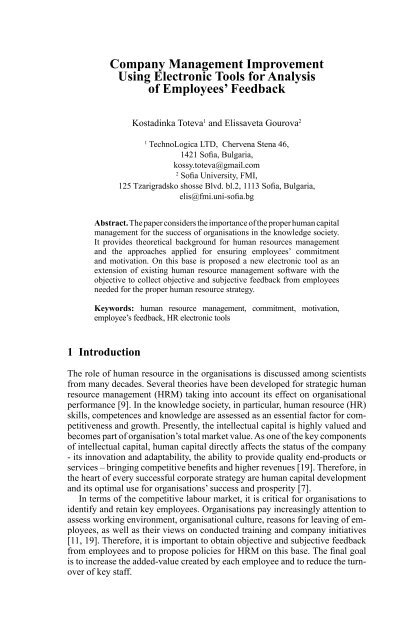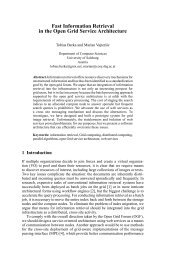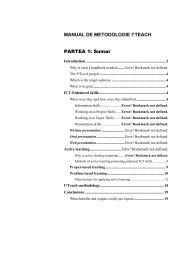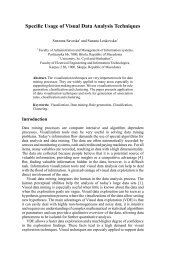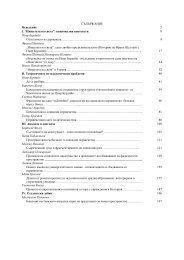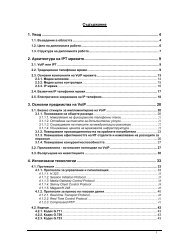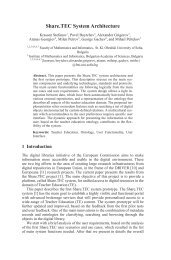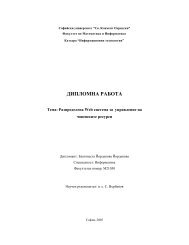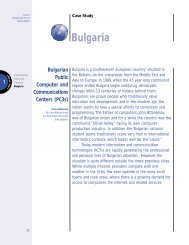Company Management Improvement Using Electronic Tools for ...
Company Management Improvement Using Electronic Tools for ...
Company Management Improvement Using Electronic Tools for ...
You also want an ePaper? Increase the reach of your titles
YUMPU automatically turns print PDFs into web optimized ePapers that Google loves.
<strong>Company</strong> <strong>Management</strong> <strong>Improvement</strong><br />
<strong>Using</strong> <strong>Electronic</strong> <strong>Tools</strong> <strong>for</strong> Analysis<br />
of Employees’ Feedback<br />
Kostadinka Toteva 1 and Elissaveta Gourova 2<br />
1<br />
TechnoLogica LTD, Chervena Stena 46,<br />
1421 Sofia, Bulgaria,<br />
kossy.toteva@gmail.com<br />
2<br />
Sofia University, FMI,<br />
125 Tzarigradsko shosse Blvd. bl.2, 1113 Sofia, Bulgaria,<br />
elis@fmi.uni-sofia.bg<br />
Abstract. The paper considers the importance of the proper human capital<br />
management <strong>for</strong> the success of organisations in the knowledge society.<br />
It provides theoretical background <strong>for</strong> human resources management<br />
and the approaches applied <strong>for</strong> ensuring employees’ commitment<br />
and motivation. On this base is proposed a new electronic tool as an<br />
extension of existing human resource management software with the<br />
objective to collect objective and subjective feedback from employees<br />
needed <strong>for</strong> the proper human resource strategy.<br />
Keywords: human resource management, commitment, motivation,<br />
employee’s feedback, HR electronic tools<br />
1 Introduction<br />
The role of human resource in the organisations is discussed among scientists<br />
from many decades. Several theories have been developed <strong>for</strong> strategic human<br />
resource management (HRM) taking into account its effect on organisational<br />
per<strong>for</strong>mance [9]. In the knowledge society, in particular, human resource (HR)<br />
skills, competences and knowledge are assessed as an essential factor <strong>for</strong> competitiveness<br />
and growth. Presently, the intellectual capital is highly valued and<br />
becomes part of organisation’s total market value. As one of the key components<br />
of intellectual capital, human capital directly affects the status of the company<br />
- its innovation and adaptability, the ability to provide quality end-products or<br />
services – bringing competitive benefits and higher revenues [19]. There<strong>for</strong>e, in<br />
the heart of every successful corporate strategy are human capital development<br />
and its optimal use <strong>for</strong> organisations’ success and prosperity [7].<br />
In terms of the competitive labour market, it is critical <strong>for</strong> organisations to<br />
identify and retain key employees. Organisations pay increasingly attention to<br />
assess working environment, organisational culture, reasons <strong>for</strong> leaving of employees,<br />
as well as their views on conducted training and company initiatives<br />
[11, 19]. There<strong>for</strong>e, it is important to obtain objective and subjective feedback<br />
from employees and to propose policies <strong>for</strong> HRM on this base. The final goal<br />
is to increase the added-value created by each employee and to reduce the turnover<br />
of key staff.
208 K. Toteva and E. Gourova<br />
One of the major changes with the rapid development of In<strong>for</strong>mation and Communication<br />
Technologies (ICT) in last decades is their impact on operation of<br />
organisations and their wide adoption in support of management, and in particular<br />
in HRM [12]. HRM systems (HRMS) facilitate the provision of quality<br />
in<strong>for</strong>mation to decision makers, ensure cost-efficiency management, and are<br />
crucial <strong>for</strong> learning organisations where HR provide many benefits [10, 16, 19].<br />
The increased use of ICT facilitates the work of HR professionals and raises<br />
significantly their per<strong>for</strong>mance and participation in internal consultancy activities<br />
[13, 14]. Un<strong>for</strong>tunately, in most cases ICT tools used by HR specialists do<br />
not include modules <strong>for</strong> surveys of employees. Traditionally, they are composed<br />
of modules on HR planning, salary advising, benefits administration, industrial<br />
relations, assessment and training needs, recruitment and per<strong>for</strong>mance management<br />
[10, 16]. However, conducting regular surveys among employees could be<br />
an essential tool <strong>for</strong> taking decisions by involving organisations staff. Presently,<br />
it makes no sense of using traditional e-mail or paper-based surveys, when e-<br />
tools offer many benefits like lower costs, broader distribution, improved accuracy<br />
of data, faster survey turnaround times, faster processing of results, greater<br />
flexibility in data analysis and reporting, etc. [15, 16]. There<strong>for</strong>e, it is essential<br />
to create survey modules, if not available, and integrate them to the existing<br />
HRMS [1]. This could also support knowledge management practice providing<br />
opportunities <strong>for</strong> faster identification and analysis of available knowledge,<br />
skills and competencies in the organisation or their possible gaps [17].<br />
This paper takes into consideration the importance of communication with<br />
employees <strong>for</strong> proper company management. The theoretical background provided<br />
in the second part highlights the importance of human resource management<br />
and the possible strategies <strong>for</strong> employees’ commitment and motivation. It<br />
focuses on the importance of feedback and communication employees <strong>for</strong> the<br />
proper design of HR strategy and its implementation plans. There<strong>for</strong>e, the third<br />
part presents a HRM product HeRMeS V and the Surveys module additionally<br />
designed and integrated to the system in order to support the proper decision<br />
making process and improving the organisational culture and HRM practice.<br />
Finally, the paper presents some results of the practical implementation and<br />
testing of the new module.<br />
2 Commitment and motivation of employees<br />
HR management is defined as ‘a strategic and coherent approach to the management<br />
of an organisation’s most valued assets – the people working there who<br />
individually and collectively contribute to the achievement of its objectives’<br />
[7]. Storey [2] considers that HR management can be regarded as a ‘set of<br />
interrelated policies with an ideological and philosophical underpinning’. He<br />
suggests four aspects of HR management:<br />
• specific constellation of beliefs and assumptions<br />
• strategic thrust in<strong>for</strong>ming decisions about people management<br />
• central involvement of line managers<br />
• reliance upon a set of ‘levers’ to shape the employment relationship.
<strong>Company</strong> <strong>Management</strong> <strong>Improvement</strong> 209<br />
2.1 Basic concepts<br />
HRM is integral part of the strategy <strong>for</strong> achieving the business goals of the<br />
organisation and its social functions. It is focused on management of employment<br />
relationship, resourcing, learning and development, per<strong>for</strong>mance management,<br />
reward, and employee relations [7]. Finding methods <strong>for</strong> motivation<br />
and creating engagement of employees is one of the fundamental management<br />
challenges, especially in the time of rapid progress, changes and pressures to<br />
achieve better productivity and per<strong>for</strong>mance. As defined by Porter et al. [8],<br />
commitment refers to attachment and loyalty. It is the relative strength of the<br />
individual’s identification with, and involvement in, a particular organisation.<br />
It consists of three factors [8]:<br />
•<br />
•<br />
•<br />
strong desire to remain a member of the organisation<br />
strong belief in, and acceptance of, the values and goals of the organisation<br />
readiness to exert considerable ef<strong>for</strong>t on behalf of the organisation<br />
Subsequently, engagement is defined as ‘a positive, two-way, relationship<br />
between an employee and its organisation’ [9]. Enhancing job engagement<br />
starts with job design and focuses on the provision to employees of interest<br />
and challenge, variety, autonomy, task identity and task significance [7]. There<strong>for</strong>e,<br />
the awareness of the needs of employees and satisfying them could be<br />
an important step to engage workers fully <strong>for</strong> achievement of the organisations’<br />
goals. This concept requires building an environment which motivates<br />
employees and provides them opportunities <strong>for</strong> establishing close relations with<br />
colleagues, managers and the organisation as a whole. The flexibility, change<br />
and continuous improvement should be in the centre of HR management <strong>for</strong><br />
ensuring engagement and motivation of employees [6].<br />
The high level of motivation is very important <strong>for</strong> achieving a high level<br />
of engagement. Many concepts rely on meeting individuals’ needs. One of the<br />
most popular motivation models is the needs model of Maslow [4]. He believes<br />
that the content of motivation consists of needs, and the unsatisfied needs create<br />
tension and a state of disequilibrium which motivates the behaviour of people<br />
and their actions towards satisfaction of these needs and achievement of the<br />
selected goals. Maslow considers that all personal needs are in a hierarchy (Fig.<br />
1) which consists of five major categories starting from the fundamental physiological<br />
needs, followed by safety, social and esteem needs, and on the top the<br />
need <strong>for</strong> self-fulfilment [7].<br />
The following characteristics were pointed out by Lawler [3] as requirement<br />
in jobs in order to be intrinsically motivating:<br />
• Feedback – individuals must receive meaningful feedback about their per<strong>for</strong>mance,<br />
preferably by evaluating their own per<strong>for</strong>mance and defining the<br />
feedback.<br />
• Use of abilities – the job must be perceived by individuals as requiring them<br />
to use abilities they value in order to per<strong>for</strong>m the job effectively.<br />
• Self-control – individuals must feel that they have a high degree of selfcontrol<br />
over setting their own goals and over defining the paths to them.
210 K. Toteva and E. Gourova<br />
Very important part of programs <strong>for</strong> HR motivation is focused on creating<br />
employees’ sense of self-confidence <strong>for</strong> taking individual decisions and making<br />
the first steps in innovations, creating sense of having enough knowledge and<br />
in<strong>for</strong>mation <strong>for</strong> achieving good results in professional aspect, creating sense<br />
that every person is treated with respect and of course good rewards <strong>for</strong> well<br />
done job.<br />
Fig. 1. Needs hierarchy according to Maslow [18].<br />
2.2 Approaches of employees’ commitment and motivation<br />
There is no universal <strong>for</strong>mula that specifies how to create a sense of commitment<br />
and engagement of employees. Some good practices could be pointed out<br />
that affect the level of engagement of employees. Generally, the approaches can<br />
be divided into the following categories [1]:<br />
•<br />
•<br />
•<br />
Approaches related to organisational culture and leadership<br />
Approaches related to personal development of each employee<br />
Approaches concerning salary and financial rewards<br />
The first category is characterised with application at organisational level,<br />
while the second category concerns individuals, and can be applied to a specific<br />
employee. It is important to have clear criteria <strong>for</strong> choosing employees,<br />
and cases in which these approaches will be applied <strong>for</strong> the whole organisation.<br />
With regard to salary and financial rewards, the approaches can be applied<br />
either to the entire company or to a specific department.<br />
Several methods could be found in practice aimed at proper HR management<br />
and in particular motivation and commitment of employees [1]:<br />
A. Inspired Leadership: Managers and team leaders in companies, recognized<br />
as good employers, realize that people are their most important resource.<br />
They assess that the close communication with employees gives opportunity to
<strong>Company</strong> <strong>Management</strong> <strong>Improvement</strong> 211<br />
understand better employees’ needs and this leads to easy identifying personal<br />
motivator. According to Hewitt [5], the following actions are critical:<br />
• Breaking the distance between managers and employees – through regular<br />
meetings of the management with employees.<br />
• Ensuring clear vision and focus – <strong>for</strong> the actual situation in the organisation,<br />
its business strategy and objectives.<br />
• Encouraging transparency and initiative – through corporate culture<br />
based on transparency and consultations in the decision making process<br />
and priorities setting.<br />
B. Unique Corporate Culture: The organisational culture is reflected in company<br />
philosophy and vision, management style, and its physical organisational<br />
structures. It includes norms, values, beliefs and ways of behaviour that characterize<br />
the manner in which groups and individuals work together [7]. Every<br />
organisation has its own unique culture which in most cases is based on the<br />
values of the top management or the founders. Over time, individuals attempt<br />
to change the culture of their organisations to fit to their own preferences or the<br />
changing market conditions. This culture then influences the decision-making<br />
processes and management styles.<br />
According to a survey [5] companies with adaptive corporate culture have<br />
at least 2 times higher per<strong>for</strong>mance and financial results then their competitors.<br />
To achieve such results, the company must identify its current organisational<br />
culture, determine what it should be and take appropriate actions to adopt the<br />
desired culture.<br />
C. Strong Sense of Accountability: Successful companies demonstrate their<br />
respect to their employees using the sense of accountability <strong>for</strong> results and recognizing<br />
employees’ achievements. They have well-developed policies <strong>for</strong><br />
productivity management, which strengthen collaboration among employees<br />
and the company per<strong>for</strong>mance.<br />
D. Effective Change <strong>Management</strong>: Each company is changing more or less<br />
over time. The changes usually create additional stress and tension in companies,<br />
so as their proper implementation is critical to maintain satisfaction and<br />
motivation of employees. Although each change is unique, there are common<br />
approaches which are better to be respected in order to make the change possible<br />
and painless, and to maintain the engagement of employees [5]:<br />
• Effective leadership: there are many styles of management (command,<br />
consultative, collaborative, etc), each of which is appropriate in certain<br />
situations.<br />
• Appropriate and timely training - it is considered to be the most important<br />
factor <strong>for</strong> successful implementation of change.<br />
• Two-ways communication with employees and their active participation<br />
in implementing the change helps to eliminate the resistance to<br />
changes.<br />
E. Aligned HR Practices: According to survey data [5], 80% of employees in<br />
the best European companies claim that the policies <strong>for</strong> HRM of their companies<br />
are consistent with business strategy and expectations <strong>for</strong> achieving business<br />
goals. By comparison, in other companies only 49% of employees think so.
212 K. Toteva and E. Gourova<br />
An example of purposeful practice <strong>for</strong> HRM is the working flexibility. Flexible<br />
working time and remote access to company resources are effective tools<br />
that help employees to find work-life balance, the balance between the sense of<br />
involvement and engagement and the sense of personal freedom. Similarly, the<br />
communication strategy is a valuable tool targeted at clarification of corporate<br />
mission, strategy, objectives and processes which motivate employees to remain<br />
and engage them better in all organisational processes [7].<br />
F. Growing Talent: Good employers offer to their employees more opportunities<br />
<strong>for</strong> personal and professional growth. They notice the talented workers<br />
and provide them with enhanced training and career advancement opportunities.<br />
In such organisations the practice to devote more time and funds <strong>for</strong> actively<br />
developing a higher potential and offering alternatives <strong>for</strong> career progress is<br />
established.<br />
G. Flexible Benefits: Flexible benefits plan is a <strong>for</strong>malized system that allows<br />
variation in the way of payment in order to fully meet the needs of employees.<br />
Flexible benefits plan provides employees with a degree of choice on<br />
what benefits they want, according to their needs. A study of British Institute of<br />
Personnel and Development shows that just over 10% of employers use such<br />
plan [6]. These are mainly private companies with more than 5000 employees.<br />
HR policy has a direct impact on product or service quality, the market position,<br />
labour efficiency, production cost, etc. [9]. Experience shows that companies<br />
implementing commitment strategies are more successful. For this strategy<br />
it is necessary to provide a mechanism <strong>for</strong> obtaining feedback from employees<br />
in order to update the working processes and to identify problems and there<strong>for</strong>e<br />
to generate ideas <strong>for</strong> their decisions, as well as to identify levels of engagement<br />
and determine the most appropriate incentives and factors <strong>for</strong> improving the<br />
working environment. There is a need to encourage employees to give regular<br />
feedback in order to create the conditions <strong>for</strong> creativity and to engage them<br />
stronger to the organisation. Such surveys become a powerful management<br />
tool which increasingly is going into practice. A HRMS is necessary to provide<br />
similar functionality <strong>for</strong> maximizing the awareness of opportunities and employees’<br />
status. The survey may be in different areas, even indirectly associated<br />
with the HRM, in order to support the management policy of the organisation<br />
and its practical implementation.<br />
3 Еxample of electronic tools <strong>for</strong> analysis of employees’ feedback<br />
HeRMeS is a software product specialized in ensuring HRM activities, and it<br />
has been used since 1996. HeRMeS V is the newest version which is conceptually<br />
different from the previous ones. HeRMeS V is on the market from more<br />
than two years and it evolves with adding new features. It is a flexible system<br />
that is easy adaptive to organisation’s culture and needs. The interface of the<br />
system is user-friendly and the <strong>for</strong>ms are unified.<br />
<strong>Using</strong> instruments that are not part of or integrated to HRMS <strong>for</strong> obtaining<br />
feedback would lead to inconsistence to basic data such as employee expertise,<br />
education, qualifications, training, etc. This would hamper the analysis of<br />
surveys and even would lead to loss of in<strong>for</strong>mation and incorrect evaluation of<br />
policies <strong>for</strong> HRM. That inducted the development of Examinations and Surveys<br />
Modules <strong>for</strong> the HRMS HeRMeS V in order to satisfy the need of integrated<br />
tools <strong>for</strong> collecting feedback from employees [1].
<strong>Company</strong> <strong>Management</strong> <strong>Improvement</strong> 213<br />
HeRMeS V is a module based plat<strong>for</strong>m and serves a wide range of HR activities.<br />
The main modules are divided into three groups (Fig. 2) [1]:<br />
• Standard modules: They are included in the basic version of the system,<br />
serving HRM operational activities. These modules are intended<br />
<strong>for</strong> use by HR professionals. The modules Personnel and Structures are<br />
essential because they maintain the in<strong>for</strong>mation about employees, their<br />
current assignments and the structure of the company.<br />
• Additional modules: They provide interfaces to other systems and ensure<br />
generalised in<strong>for</strong>mation <strong>for</strong> business purposes. The system can<br />
exist and work properly without these modules.<br />
• Self-Services: These are web-based modules, intended <strong>for</strong> use by each<br />
employee. They are mainly used <strong>for</strong> operating activities that do not require<br />
specialized intervention of a HRM specialist. For example: The<br />
employee applies <strong>for</strong> leave electronically in Self-Service Leaves. The<br />
system is set <strong>for</strong> the levels of approval and launches a process that requires<br />
approval by all persons involved in it – team leader, leader, etc.<br />
After final approval the leave data is inserted in HeRMeS V standard<br />
module Leaves and this data are taken into account in calculating salary.<br />
Fig. 2. Modules in HeRMeS V.<br />
The three groups of modules are available to employees of the organisation.<br />
However, some processes require the system to be accessed by persons who are<br />
not employees of the organisation, e.g. a person applying <strong>for</strong> a job vacancy. The<br />
HeRMeS V portal ensures bringing together all HRM activities supported by the<br />
system which require interaction of non-employees.
214 K. Toteva and E. Gourova<br />
3.1 Design of e-tool <strong>for</strong> employees’ feedback<br />
The purpose of the Surveys module is to provide the necessary functionality<br />
<strong>for</strong> a survey of employees at certain moment - after training or when leaving,<br />
etc. The module supports the analysis of the state-of-the-art in the company,<br />
linked <strong>for</strong> example to engagement, commitment and motivation of employees.<br />
The main function of the module, there<strong>for</strong>e, is to enable conducting of surveys<br />
among employees and facilitate processing of the results of their feedback. The<br />
standard questionnaires contain questions of three types – open-ended, multiple-choice<br />
and free text questions [1].<br />
In order to achieve the objectives of HRM, various scenarios were discussed<br />
<strong>for</strong> the use of this module and on this base it was designed. In developing the<br />
scenarios the different roles and actions (HR specialist and employee roles)<br />
were taken into account and some use-cases were created [1].<br />
The Surveys module provides an interface to the employee and ensures the<br />
analysts not to loose time <strong>for</strong> manual entry of responses (typical <strong>for</strong> paper-based<br />
surveys), and provides them the opportunity <strong>for</strong> diverse reporting. There<strong>for</strong>e, in<br />
addition to the Surveys module which is used by HR specialists, a Self-Service<br />
Surveys is designed where respondents give their answers on-line. Thus, the<br />
process of working with the module is divided into three main parts:<br />
1. Creating the survey and rules <strong>for</strong> processing the results, and determining<br />
employees who will take part in the survey<br />
2. Filling the electronic blank by employees using the Self Service Surveys<br />
3. Analysis of the results from the survey.<br />
HR specialists are in charge of creating the survey and defining the questions<br />
and how the results will be reported, as well as associating evaluation rules<br />
with a question, block or the whole survey <strong>for</strong> ensuring flexible reporting. The<br />
final step of the survey creation is associating it to employees who will respond<br />
it. Subsequently, employees fill-in the questions through Self Service and the<br />
answers are placed in a data base in order to be analysed later. They need a web<br />
browser to fill-in the survey. The latter is visible in their profiles in Self Services<br />
of the organisation. Since the Surveys module is provided as a standard functionality,<br />
it is embedded in the Personnel module plug-in.<br />
The results could be delivered and analysed using reports in different <strong>for</strong>mat:<br />
in MS Word, MS Excel or Adobe Acrobat. The export of accumulated<br />
results to MS Excel gives the opportunity <strong>for</strong> using all the functionality of MS<br />
Excel <strong>for</strong> appropriate view. Reports <strong>for</strong> generalised results use MS Excel, so<br />
that data can be processed according to the requirements of the particular survey.<br />
Due to the variety of surveys, the design of the module provides <strong>for</strong> the use<br />
of rules - part of the standard functionality of HeRMeS V, which allows code of<br />
function to be manipulated and the function to be called according to specification.<br />
This ensures alternative calculation according to the survey-associated<br />
rules. Without these rules only the standard reporting is accessible, but if no<br />
one of the standard designed rules applies to the business needs, fast and easy<br />
a new rule could be created. The main idea is a database of rules to be created<br />
by developing step-by-step rules. This will ensure that only the needed rules<br />
are developed.
<strong>Company</strong> <strong>Management</strong> <strong>Improvement</strong> 215<br />
A standard Plug-in technology is applied in the development of the module<br />
<strong>for</strong> the desktop application which will be used by HR specialist. Components<br />
of Self Service modules are developed through ASP.NET and include both updating<br />
data from employees and management of business processes. For these<br />
features Microsoft. NET Framework 3.0 and Workflow Foundation are used.<br />
The technology allows setting of specific business processes without writing<br />
additional code and reinstalling the application.<br />
Finally, the Surveys module is linked to the procedure <strong>for</strong> job resignation –<br />
by cancelling the work contract automatically is generated a questionnaire and<br />
associated to the leaving employee. It is called exit interview. This automatisation<br />
allows easy conducting such survey and overcoming the fact that often HR<br />
specialists <strong>for</strong>get them. Besides, the employee could provide in<strong>for</strong>mation about<br />
new employer, new position and general comments. There<strong>for</strong>e, it is necessary<br />
to develop a specific user interface <strong>for</strong> exit interview of type self-service. It is<br />
logical to use the standard survey interface, so through special web button the<br />
employee fills in his/her survey part from the exit interview [1].<br />
3.2 Practical results of module implementation<br />
The tests <strong>for</strong> usability and functionality of the newly designed Surveys module<br />
were conducted in an organisation operating in the IT sector. In the organisation<br />
work about 250 employees. Its structure includes several standard functional<br />
departments: Administration, Accounting, Human resource, etc., and two specialized<br />
departments - one that develops software <strong>for</strong> customer “on demand”<br />
and one that develops and maintains the organisation’s main software product.<br />
The staff hierarchy is on three levels - operational staff, team leaders and managers.<br />
Fig. 3. Satisfaction with working environment.<br />
In the study of the working environment was used a survey consisting of 25<br />
closed questions and one multiple-choice question. The study aimed to determine<br />
employee satisfaction on five key factors of the working environment [1]:<br />
• relationships within the team<br />
• satisfaction of the salary<br />
• evaluation of the feedback system (per<strong>for</strong>mance management)
216 K. Toteva and E. Gourova<br />
•<br />
•<br />
work nature<br />
training and growth opportunities<br />
At Fig. 3 are illustrated the levels of satisfaction of the five factors. It is clear<br />
that employees are satisfied in most of the relationships between colleagues<br />
(73.00%) and work nature (69.33%). Factors characterized by lower satisfaction<br />
are per<strong>for</strong>mance management (47.31%), opportunities (46.59%) and level<br />
of salaries (43.11%).<br />
So far, this company did not per<strong>for</strong>m such kind of investigation and this<br />
survey provided basic in<strong>for</strong>mation <strong>for</strong> identifying problems, analyzing alternatives,<br />
and deciding on further actions to increase the satisfaction with the<br />
factors of the working environment considered in the survey. Although this is<br />
the first online survey in the company the HR specialists claim that the tool is<br />
easy-to-use and saves much time.<br />
4 Conclusions<br />
Currently, the competitive advantages of companies are <strong>for</strong>med primarily on the<br />
basis of knowledge. There<strong>for</strong>e, human capital is an important factor. Training<br />
and integration of new employees in an organisation requires time and resources<br />
that may be significant. It is difficult to “grow” and maintain an employee<br />
who is not only doing well his obligations, but also carries out his activities<br />
with enthusiasm. Subsequently, companies use different practices to motivate<br />
and engage employees and retain valuable staff - trans<strong>for</strong>ming the relationship<br />
between manager and subordinate, seeking a unique corporate culture, trying to<br />
<strong>for</strong>m a strong sense of responsibility among employees, implementing changes<br />
in business policies and guidelines in consultation with employees, implementing<br />
flexible benefits plans, looking <strong>for</strong> talent, etc.<br />
The developed Surveys module provides the needed up-to-date functionality<br />
<strong>for</strong> organisations. Naturally, in the future when organisations will change their<br />
needs the module will be adapted. For example, presently the employee could<br />
not fill in his/her survey anonymously because this has to be done through his/<br />
her profile. In this case, the only alternative is a paper-based survey. There<strong>for</strong>e,<br />
IT tools should integrate such functionalities in order to provide diversity and<br />
to satisfy the organisations needs.<br />
Obviosly, organisations using IT to obtain feedback from their employees<br />
have competitive advantage. They can af<strong>for</strong>d to conduct a survey <strong>for</strong> less than<br />
a day and to analyze their strategies more frequently, as well as maintain their<br />
valuable human capital. On the other hand, technology enables HR professionals<br />
to focus on analyzing data rather than processing. Last, but not least, employees<br />
might be better motivated to fill-in surveys when provided electronically in a<br />
user-friendly way with available help-desk support, and remote access opportunities.<br />
It is expected more software products to appear on the market and to<br />
offer functionality <strong>for</strong> collecting and analyzing feedback from employees. This<br />
could be especially useful <strong>for</strong> analyzing the knowledge landscape in the organisation<br />
be<strong>for</strong>e any knowledge management initiative or regular monitoring of its<br />
implementation and effectiveness [17].
<strong>Company</strong> <strong>Management</strong> <strong>Improvement</strong> 217<br />
Acknowledgеments. The authors would like to express their gratitude to people<br />
from TechnoLogica LTD who supported them, and especially to Pavel Petrov<br />
whose expertise, understanding, and patience, added considerably new value<br />
to this work.<br />
References<br />
1.<br />
2.<br />
3.<br />
4.<br />
5.<br />
6.<br />
7.<br />
8.<br />
9.<br />
10.<br />
11.<br />
12.<br />
13.<br />
14.<br />
15.<br />
16.<br />
17.<br />
18.<br />
19.<br />
Toteva, K.: IT use <strong>for</strong> analysis of employees’ feedback with the objective of HR<br />
management, MSc Thesis, Sofia University (2010)<br />
Storey, J.: New Perspectives on Human Resource <strong>Management</strong>, Routledge (1989)<br />
Lawler, E E.: Job design and employee motivation, Personnel Psychology, 22,<br />
426–35 (1969)<br />
Maslow, A.H.: A Theory of Human Motivation, Psychological Review 50(4), 370-<br />
96 (1943)<br />
Hewitt Associates: What Makes a Best Employer, http://www.hewittassociates.com<br />
Chartered Institute of Personnel and Development: An HR director’s guide to employee<br />
engagement, http://www.cipd.co.uk/<br />
Armstrong, M.,: A handbook of Human Resource <strong>Management</strong> Practice(2006)<br />
Porter, LW, Steers, R, Mowday, R and Boulian, P: Organisational commitment,<br />
job satisfaction and turnover amongst psychiatric technicians, Journal of Applied<br />
Psychology, 59, 603–09 (1974)<br />
Lengnick-Hall, M.L., C.A. Lengnick-Hall, L.S.Andrade, B.Drake: Strategic human<br />
resource management: The evolution of the field, Human Resource <strong>Management</strong><br />
Review, 19, 64-85 (2009)<br />
Hussain, Z., J.Wallace, N.E.Cornelius: The use and impact of human resource in<strong>for</strong>mation<br />
systems on human resource management professionals, In<strong>for</strong>mation &<br />
<strong>Management</strong> 44, 74-89 (2007)<br />
Collins, B., Meeting Employee Expectations: Exploring Change through Employee<br />
Feedback, Journal of Environmental Health, 64, 30-33 (2002)<br />
Spanos, Y.E., G.P.Prastacos, A.Poulymenakou: The relationship between in<strong>for</strong>mation<br />
and communication technologies and management, In<strong>for</strong>mation & <strong>Management</strong>,<br />
39, 659-675 (2002)<br />
Ulrich, D.: Human Resource Champions: The Next Agenda <strong>for</strong> Adding Value to<br />
HR Practices, Harvard Business School Press, Boston, MA (1997)<br />
Softworld Report, Human Resource <strong>Management</strong> Software, Conspectus, PMP<br />
(UK) Ltd. (1997)<br />
Klassen, R.D., J.Jacobs, Experimental comparison of Web, electronic and mail survey<br />
technologies in operations management, Journal of Operations <strong>Management</strong><br />
19, 713–728 (2001)<br />
Martinsons, M.G.: Human resource management applications of knowledge-based<br />
systems, Int. Journal of In<strong>for</strong>mation <strong>Management</strong> 17(10), 35-53 (1997)<br />
Gourova, E., A. Antonova, Y. Todorova: Knowledge audit concepts, processes and<br />
practice, WSEAS TRANSACTIONS on BUSINESS and ECONOMICS 12(6),<br />
605-619 (2009)<br />
Wikipedia, http://en.wikipedia.org<br />
Debowski, S: Knowledge <strong>Management</strong>, John Wiley & Sons Australia Ltd., Sidney<br />
(2006)


